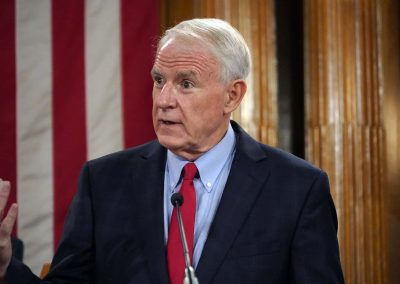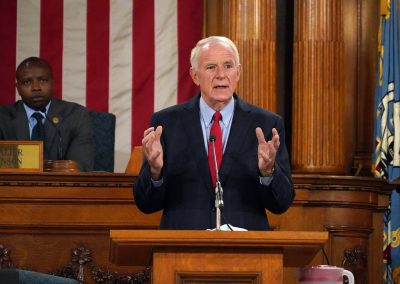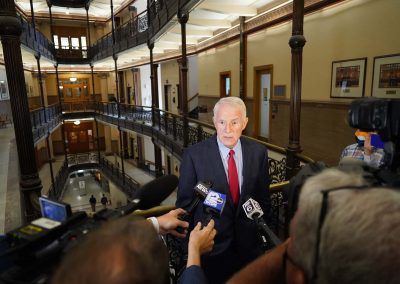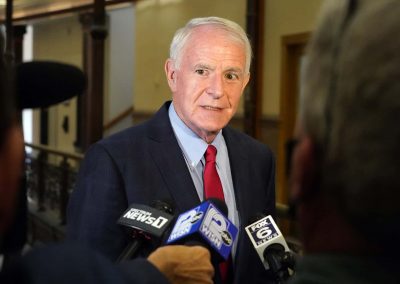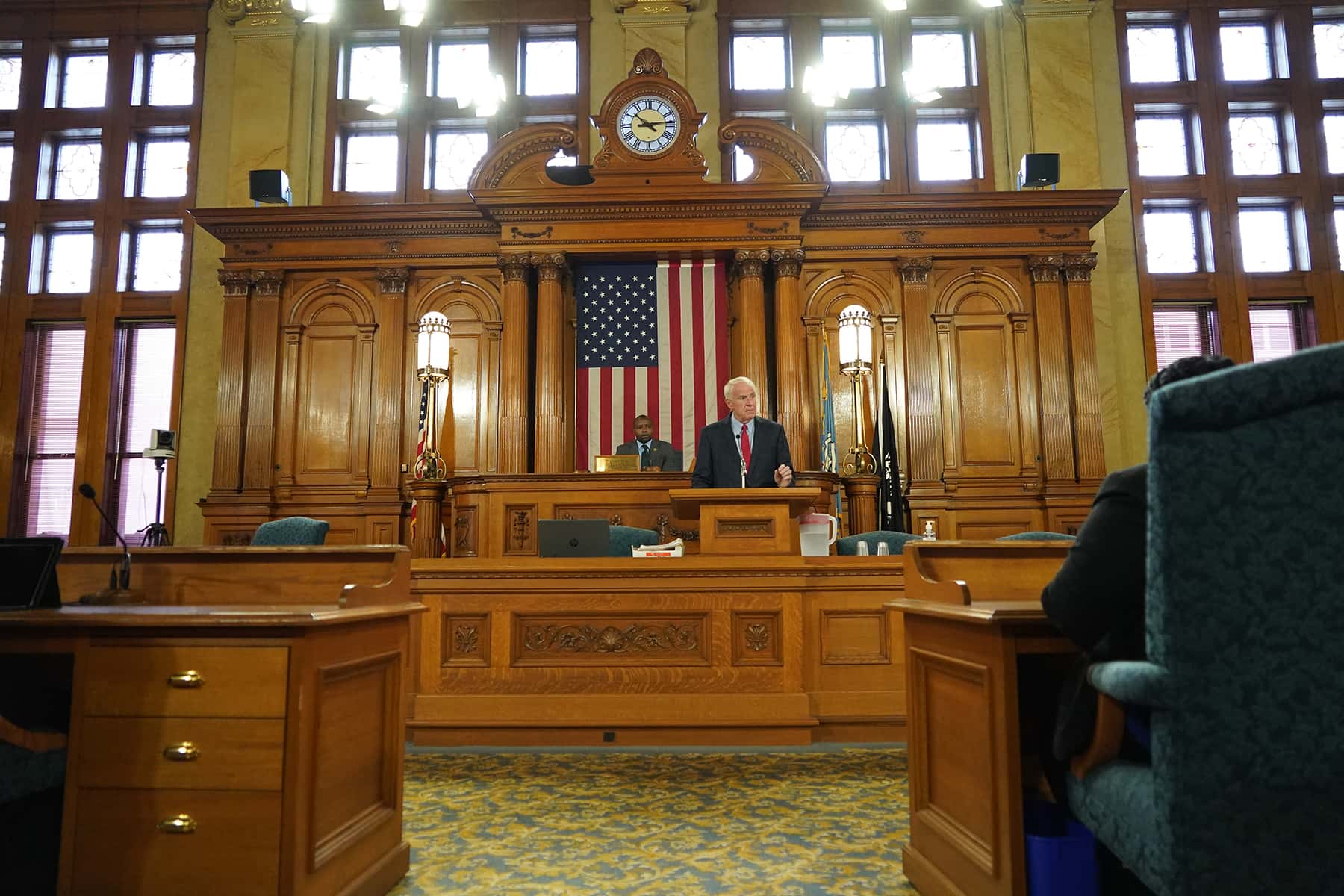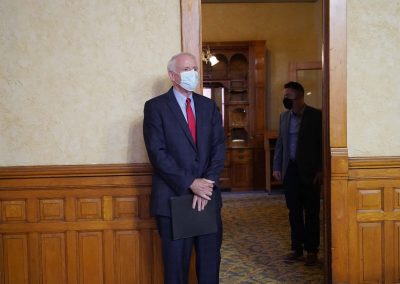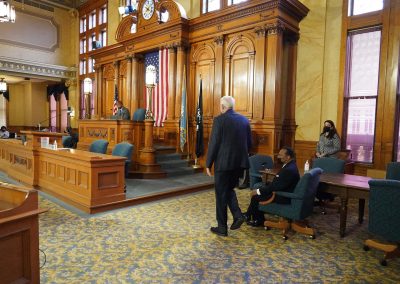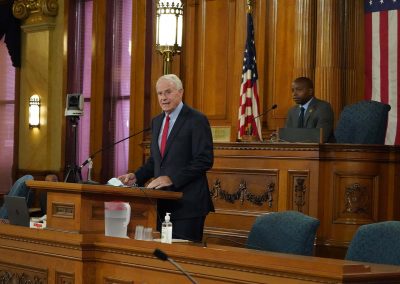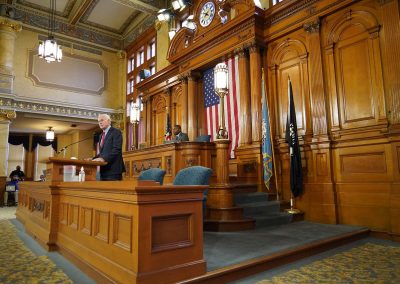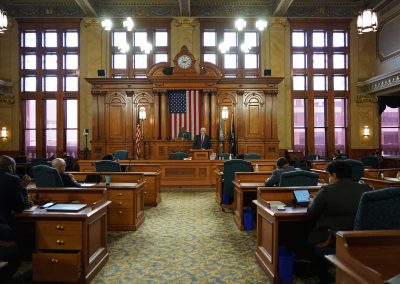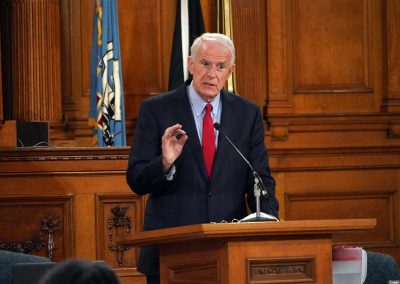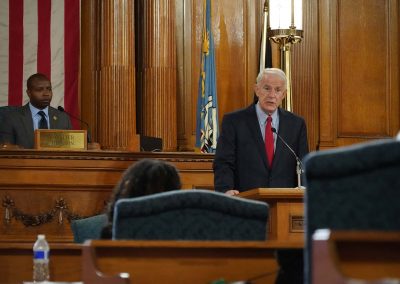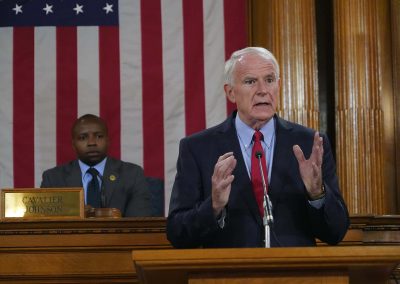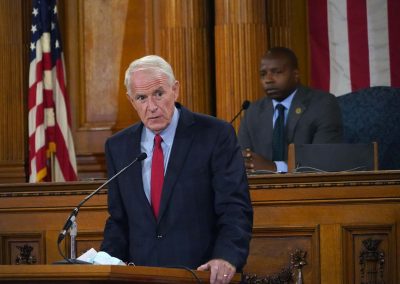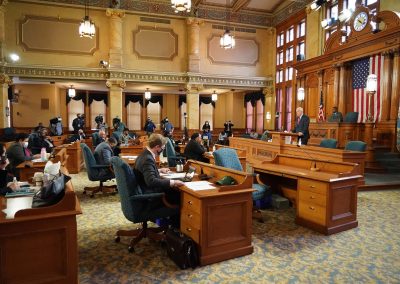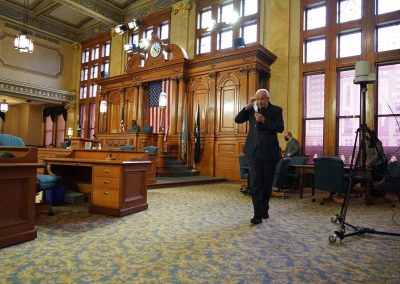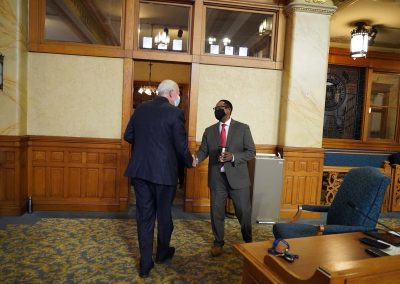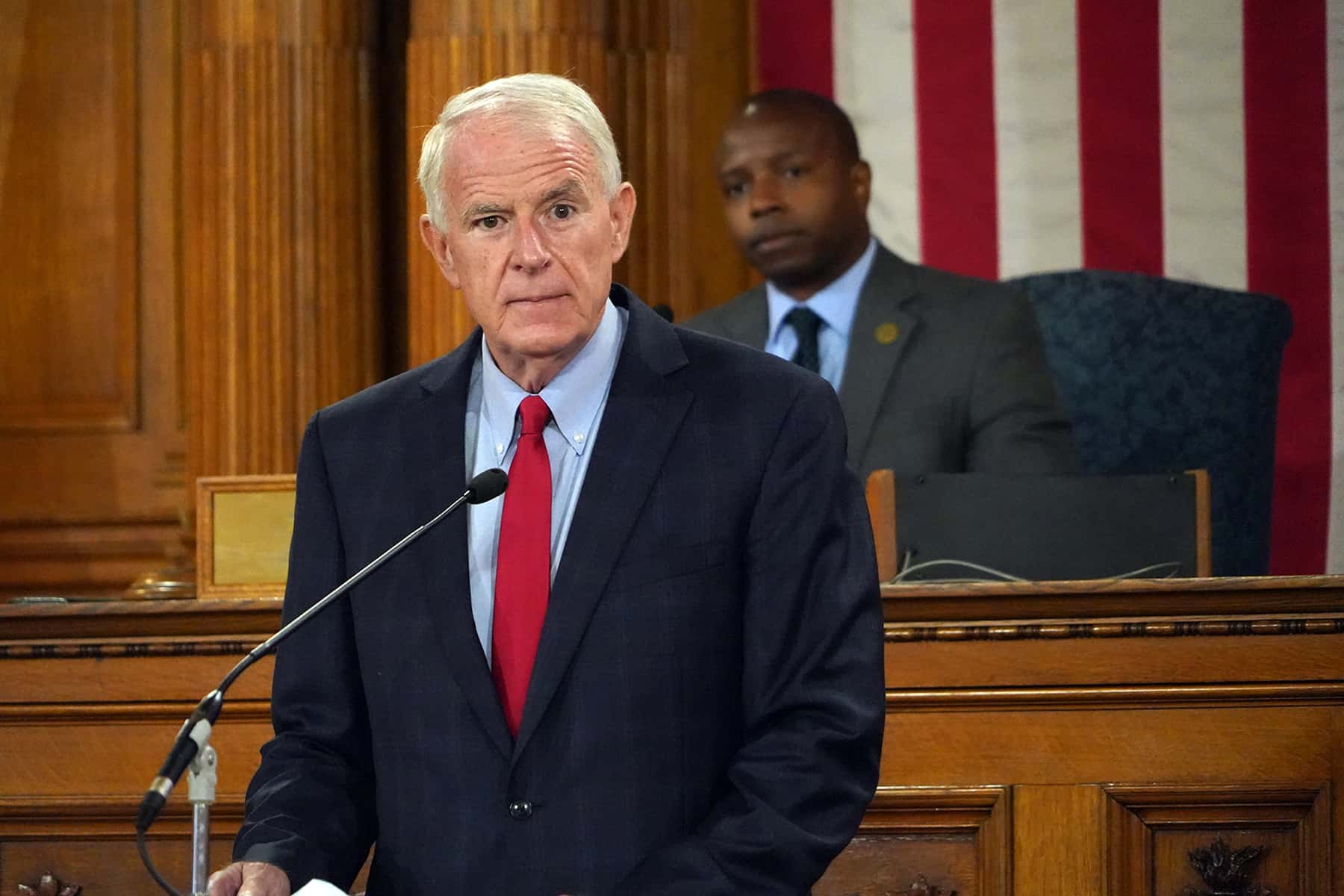
Milwaukee Mayor Tom Barrett presented the Common Council with his 2022 budget on September 21, highlighting the fiscal challenges ahead due to the Republican-dominated state legislature’s refusal to give the city the tools it needs.
The Milwaukee Common Council has until November 5 to make changes to Mayor Barrett’s budget proposal. It will also be the last budget drafted by the Mayor, as he is awaiting Senate confirmation to serve in the Biden administration as the new U.S. ambassador to Luxembourg.
The proposed $1.7 billion budget for Milwaukee will be supported by $305.2 million in property taxes, up 2 percent from the 2021 budget. If approved, the average residential property owner will pay close to an additional $33 in taxes.
“The reality is the 2022 Milwaukee budget is, in many ways, the calm before the storm,” said Mayor Barrett in his address. “The looming challenges are ominous: our pension obligations, constrained revenue options, and state shared revenue that remains unchanged—declining in real value—over recent decades.”
Mayor Barrett emphasized that Milwaukee simply did not have the sufficient ability to address all the challenges it faced locally. The city needed the state Legislature to finally become a partner, and act on multiple fronts to give Milwaukee the tools it needed.
He noted that the emergency federal funds given to the city through the American Rescue Plan Act (ARPA), had provided the Milwaukee with a chance to take significant steps toward building a more resilient community. But when the ARPA funding ends in 2022, the city could be in a very dire situation after two years of pandemic conditions.
Common Council President Cavalier Johnson released a response to the Mayor’s budget, outlining the need to balance the needs of an entire city.
Mayor Tom Barrett’s 2022 Executive Budget Address
Mr. President, Common Council members, officials and dignitaries,
It is my honor to present the 2022 City of Milwaukee Executive Budget. It is a careful compilation of municipal duties, priorities, and ambitions — all balanced by the fiscal limitations that dominate our planning efforts.
These fiscal constraints include our pension obligations, our restricted revenue options, and the refusal of the state legislature to give us the tools we need. Yes, in an era of big surpluses in the state’s coffers, the legislature’s inattention has left us with huge fiscal and public safety challenges.
We all want to do more, and, fortunately, with the American Rescue Plan funds available to us, we do have a limited opportunity to invest in employment, housing, health and safety. With ARPA funds, we can positively impact the lives of our residents who need the help the most.
And, as you will see in the budget documents, we have deployed ARPA funds, strategically, to advance departmental objectives. We have done so to avoid cuts to vital services and to avoid layoffs of City personnel. Unfortunately, I think we all recognize that the ARPA funds will not solve our structural financial challenges.
The 2022 budget I present today is bolstered with ARPA funds in the fire department, the police department, the health department, the department of public works, the library, and others.
Overall, our budget for next year is up to $1.7 billion, supported by a property tax levy of $305.2 million. That levy is 2% higher than last year, so an average residential property owner will see an increase of about $33 in taxes.
Residents will not see an increase in fees from this budget. Snow and ice, solid waste, sewer and street lighting fees all remain unchanged.
I do feel it is important to rely less on reserves than we did last year. As you know, we’ve had challenges with the bond rating agencies and we have to address them. Our use of reserves in the 2022 budget is $14 million dollars lower than this year’s budget. We are drawing fewer dollars from the Tax Stabilization Fund, fewer dollars from the Parking Fund, and fewer dollars from the Public Debt Amortization Fund.
As you all know, I have been a long-time advocate for a healthy pension reserve. This budget does that, and, in my conversations with Council members, I sense a growing appreciation for that approach. With my proposed $10 million injection into the Pension Reserve Fund, our balance will now be greater than $50 million in pension reserves.
The biggest organizational change you will see in this year’s budget is the creation of a new Department of Emergency Communications. This department builds on plans to add new levels of professional, efficient, and effective 9-1-1 emergency communications. We are consolidating the fire and police emergency communication functions to better serve our residents and to unify previously duplicated functions.
Fortunately, both public safety departments have been very cooperative and engaged in making sure the Department of Emergency Communications succeeds. Administratively, the new department will be part of the Fire and Police Commission.
The transition is already underway. In the coming year, we will transfer and add staff and work through the multitude of steps required for a safe, smooth and complete transition. The administrative changes move forward at the same time technical improvements are added.
The City of Milwaukee handles, by far, the greatest number of calls for emergency services in the county. So, the city is the logical designee as the Public Safety Answering Point for Milwaukee County. That is important because we have the planning, the people, and the initial infrastructure to take the lead. I am hopeful — and would love your support — to make sure that we receive the designation and the Next Generation 911 grants from the State of Wisconsin.
Without a doubt, we want people calling for an emergency response to get the appropriate service as quickly as possible. We want the police and fire responders to get the best support from emergency communication staff. And, we want to accomplish this with budget efficiency in mind.
The Milwaukee Fire Department will maintain services in 2022, supplemented with nearly $15 million in American Rescue Plan money. The department’s emergency medical responses have been complicated recently as the private ambulance companies — the providers of basic life support services in our community — have faced unsustainable financial challenges. In fact, as you may know, one of the companies pulled out of the market altogether. To maintain this very important system, the fire department will subsidize the private providers and train emergency responders for the private companies in the coming year.
Next year, the police department will swear in and train 195 new police officers in three police recruit classes. We will use the American Rescue Plan funds to accomplish this. While 2022 will be a busy year at the Police Academy, overall, the total strength of the department will be, on average, 1,657 — not quite keeping pace with retirements. The police budget is slightly smaller in my 2022 proposal, a change driven by fiscal realities, not philosophical concerns.
The police department is responsive to the trends that have emerged in Milwaukee. The work of the Traffic Safety Unit is focused on curbing reckless driving — a huge problem in our community. The department is similarly focused on the shocking increase in violence — particularly gun violence — that has emerged over the past two years. We need everyone in this city — including you — to step up and help us to reduce violence in Milwaukee.
This budget does recognize the reality that police, alone, cannot bring violence under control. We continue to support the work of the Office of Violence Prevention in the Milwaukee Health Department. The budget also includes resources for mental health awareness and reduction of opioid overdoses.
The health department has been very busy. It is engaged in a wide range of efforts to improve the wellness of our residents. Among the highest priorities is the protection of young residents from lead poisoning. In the City’s American Rescue Plan allocation, we are working with many of you to use more than $26 million to expand the response to and treatment of children with elevated blood lead levels. A particular focus is making homes lead-safe, and next year the target is to address lead threats in thousands of homes.
Our progress toward eliminating lead water laterals will continue with 1,100 removals. I believe that number will be much higher with federal infrastructure moneys awaiting approval in Congress.
Of course, we had all hoped that COVID would be behind us by now, and that our lives would be back to normal. That is not the case. The Milwaukee Health Department continues to do an excellent job managing the complexities of testing, vaccination, and protection of public health. Many individuals have stepped up in remarkable ways, including Commissioner Kirsten Johnson, Dr. Nick Tomaro, and literally dozens and dozens of health department employees.
COVID and its deadly disruption have had huge impacts on our economy, on our healthcare, and on the routines of our daily life. And, as I say at every opportunity, please get vaccinated and follow the safety precautions — including masking — so we can move forward. Your voices are influential. Everyone in this room has an influential voice, and we need those voices to be louder to ensure that more people get vaccinated.
Our libraries continue to be a bright spot. They will continue the great service they have long-provided to our residents. The Milwaukee Public Library has stepped up and adapted during the COVID-19 pandemic. Our central and branch libraries are reopened — with very limited modifications in their hours in 2022.
Next year, construction will begin on the new Martin Luther King branch library. Like other branch libraries, this is a neighborhood anchor. I call them mini Town Halls. And, we’ll have this new library with mixed use development as we have in different neighborhoods in the city. The new Martin Luther King library construction will be supported with about $4 million in ARPA funds — another great use of these funds. And again, thanks to the President, Senator Baldwin and Congresswoman Moore for being so supportive of these efforts.
My budget calls for an additional $3.5 million in capital funding for core infrastructure, and a total of $74.6 million for streets, bridges, street lighting, and sewers. And — just to give you a glimpse on how we put this thing together — in a change from an initial proposal presented to me, I have included capital funding to finish the City Hall foundation work. Yes, finally, the fencing, scaffolding, and construction trailers will be gone — something I’ve only seen in a few months during my entire term as Mayor, and something some of you have never seen.
The American Rescue Plan funds play an important role in this budget, and it is important to note how potentially transformative this money can be.
ARPA is not only an opportunity to heal, recover and overcome the effects of the pandemic, but it is an opening to revitalize and build anew. We have an opportunity to address the limitations of the past two years, and also to take a significant step forward in building a more resilient Milwaukee.
I have put forth an initial plan that uses funds from the federal government to address urgent, immediate needs of residents, families and neighborhoods hardest hit by COVID-19. I look forward to continuing discussions with you about how we deploy money going forward.
Whether we are allocating ARPA funds or designing the 2022 City budget, a paramount consideration is how all these pieces fit together. What resources are we putting toward housing? What improvements can we make toward safety to reduce violence and to discourage reckless driving? How can we increase job readiness and boost the economy? What basic City services do we need to improve? Fortunately, in my discussion, again, with many of you, I get a strong sense that we share common perspectives on many of these topics.
But, the reality is the 2022 Milwaukee budget is, in many ways, the calm before the storm. The looming challenges are ominous: our pension obligations, constrained revenue options, and state shared revenue that remains unchanged — declining in real value — over recent decades.
We simply do not have the sufficient ability to address these challenges locally. We do not have that ability. We need the State Legislature to be our partner, finally, and, act on multiple fronts to give us the tools we need.
Change is likely to come to city government. Nevertheless, I want to make one point very clear: I expect to be fully engaged in the budget process. Dialogue is important between the north and south ends of City Hall’s second floor so we can deliver a budget that reflects the needs and expectations of our residents.
We uniformly share a deep appreciation for Milwaukee, for the people who live here, and for the potential our city has moving forward. This budget reflects that appreciation and sets a course for positive results.
Good luck. I hope you enjoy the next six weeks. Thank you very much.
Common Council President Cavalier Johnson's 2022 Budget Response
Mayor Barrett presented his 2022 proposed budget to the Common Council and to the residents of Milwaukee. The Barrett Administration put together a budget that speaks to the difficult decisions that leaders make in trying to balance the needs of an entire city. However, with difficult decisions there are compromises. As the President of the Common Council, I look forward to helping our great city reach its full potential through transformative leadership that prioritizes financial stability, public safety, and the health of our communities.
We need to stop drawing down on our reserves if we want to avoid cutting city services substantially in the next few years. Though the 2022 budget draws less on reserves than previous budgets, it still dips into our savings intended to lessen the burden on taxpayers and keep the city financially healthy. In order to ensure the maintenance of city services we must build up our reserves — not deplete them. The City must solve our intractable structural financial imbalances, a problem that the current administration has not been able to resolve. We must partner with legislative leaders in Madison to fix this together.
Fiscal responsibility now shows our state legislators that we aren’t looking for a bailout; We want a long-term partnership which allows Milwaukee to continue to fuel economic development statewide.
We must also solve the lawlessness and crime on our streets that is traumatizing our neighborhoods. Residents deserve to feel safe and I want all children to grow up in neighborhoods free from random gunshots and daily reckless driving. In order to make our city safer for those we love, we need multi-pronged, strategic investments in public safety. Law enforcement is a part of that equation, both sworn and unsworn personnel. I sponsored a file which passed today providing $1.1 million in funding to the Milwaukee Police department to expand the work of the Traffic Safety Unit (TSU) ensuring safe streets for all and $6 million for Department of Public Works engineering solutions to promote safe driving which was unanimously sponsored by all members of the Common Council.
I participated in a ride-along with the officers of the TSU last week and saw first-hand just how critical their work is in ensuring safe neighborhoods. I also support the use of unarmed Community Service Officers (CSO) to include reckless driving outreach and mitigation and bringing CSO staffing up to previously budgeted amounts. Another key strategy to combatting crime is to ensure that residents have access to mental health care with dignity. As such, I sponsored in last year’s budget a measure to have clinicians respond along-side law enforcement officers to increase accessibility of care for those in need.
Additionally, today we also passed a measure I sponsored that will provide critically needed funding to the Milwaukee Fire Department (MFD) to help augment emergency medical response costs for ambulance services (services that include advanced life support), and additional funding for private ambulance companies that are helping us maintain full coverage across the city.
This is not just any budget cycle: This year the Common Council will simultaneously be debating how to allocate close to $180 million in the first round of federal American Rescue Plan Act (ARPA) funds. My vision for this investment is ensuring long-term financial health, increasing access to affordable housing and home ownership, and taking transformative steps toward eradicating Milwaukee’s lead crisis. Partnering with colleagues, we sponsored a ‘right to counsel’ measure (passed by the Council today) to provide preliminary investment in eviction prevention through access to legal representation for residents facing eviction, and evidence-based intervention keeping more residents in their homes and without an eviction record.
These priorities necessitate bold leadership to move Milwaukee forward. We are at an inflection point for the future of this city and it is paramount that we invest wisely now to guarantee the City’s financial health, public health and safety, as well as stable housing access.
© Photo
Lee Matz

